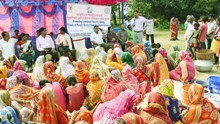
Many farmers in eastern India and coastal West Bengal, accustomed to growing rice, lentils, and traditional vegetables, are now exploring new crops that bring both nutrition and income. One such promising addition is vegetable soybean, locally known as green soy or edamame. Unlike grain soybeans harvested for seeds, vegetable soybean is harvested when pods are still green and seeds are tender at about 80 percent maturity.
The variety Swarna Vasundhara was introduced in 2008 by ICAR’s Research Center, Ranchi, and it quickly found favor in Jharkhand and nearby regions where rural communities already consume green beans and legumes. This crop not only improves dietary protein intake but also offers a short-duration harvest and good returns, making it appealing for small-scale growers.
What Makes Swarna Vasundhara Special
Swarna Vasundhara stands out for its bright green pods, often containing one to three seeds. The pods have a slightly fuzzy texture and fill well at physiological maturity. Farmers have been able to harvest yields up to 15 tonnes per hectare of green pods. These pods yield about 50 to 55 percent shelled seeds of bright green color, valued in fresh markets, local roadside stalls, and small processing units. This variety is also less prone to pests like pod borer and shows resistance to rust disease, reducing the need for heavy chemical sprays and supporting safer farming methods. Because of its bushy growth habit, it fits well into small fields and kitchen gardens.
Farming Conditions and Crop Management
Vegetable soybean fits well into the Kharif cropping system in areas of eastern and coastal India. It can be sown after the early monsoon, often in July, once the soil has warmed. Seeds should be drilled or dibbled into well-prepared, moisture-retaining soil. Raised beds or flat beds both work, but care should be taken to avoid waterlogging. Farmers need to maintain moderate plant spacing to prevent overcrowding and ensure better pod filling. Soil enriched with compost or farmyard manure supports healthy nitrogen fixation in this legume crop.
Swarna Vasundhara typically flowers about 45 days after sowing, and pods reach the edible green stage around 65 days. Harvesting must be timed carefully because green pods lose quality quickly if left too long. Manual picking is most common and helps select pods at the perfect R6 stage when seeds fill 80 percent of the pod cavity. After harvesting pods, farmers can feed the plant residue to animals or incorporate it back into fields as green manure to build soil health.
Nutrition and Market Value
Swarna Vasundhara pods are rich in digestible protein around 13 percent at the edible stage, along with healthy fats, fiber, and minerals like iron and calcium. Its green pods and sweet, non-beany flavor make it popular as a fresh vegetable snack, especially for children and health-conscious consumers. Urban markets, roadside stands, and weekly mandis welcome this novelty vegetable.
Local selling prices for fresh pods range from Rs. 150 to Rs. 200 per kilogram. When you strip the pods, the shelled beans are lighter but fetch similar or better prices per kilogram, especially when sold fresh or lightly blanched. Given an average yield of 15 tonnes of pods per hectare, net returns after harvesting and local transport can be quite encouraging for small farmers.
Challenges and Keys to Success
The vegetable soybean crop is fast-growing but perishable. Harvesting has to be precise, which means labor must be available during a brief window. The perishable nature of pods makes it unsuitable for long storage; they should reach market or consumer kitchens quickly. Another challenge is weed management, since manual harvesting does not allow for heavy mechanization, and labor cost makes up a large part of input expense. Farmers also need to be careful about spacing and water management, as salt stress or waterlogged soil can impair pod formation and yield.
However, with basic training on crop timing, seed treatment, and canopy management, growers can avoid these problems. Early harvesting, prompt local sales, and using non-toxic pest control enhance both safety and profits. Vegetable soybeans also fit well into crop rotation systems. After harvesting the pods, roots help fix nitrogen for the next crop, improving soil health.
Regional Adaptability and Expansion Potential
While Swarna Vasundhara was first promoted in Jharkhand and tribal villages of Ranchi and Khunti, its adaptability to West Bengal's coastal and Gangetic plains is now being tested with promising results. Its short duration and pest resistance make it a good option for farmers who want quick returns between longer crops like rice and lentils. Given its market demand and the growing interest in healthy local foods, vegetable soybean could become a reliable cash crop for kitchen gardeners and smallholders across eastern and central India.
For rural farmers seeking new ways to improve income and nutrition, vegetable soybean Swarna Vasundhara offers a noble opportunity. With its short crop cycle, nutritious pods, favorable prices, and compatibility with local cropping systems, it can help diversify farms, enrich diets, and bring in additional income. While it requires careful timing and hands-on care, the rewards can be substantial. With support through extension services, seed availability, and local market linkages, Swarna Vasundhara may well become a mainstream crop in India’s eastern agricultural belt.
















